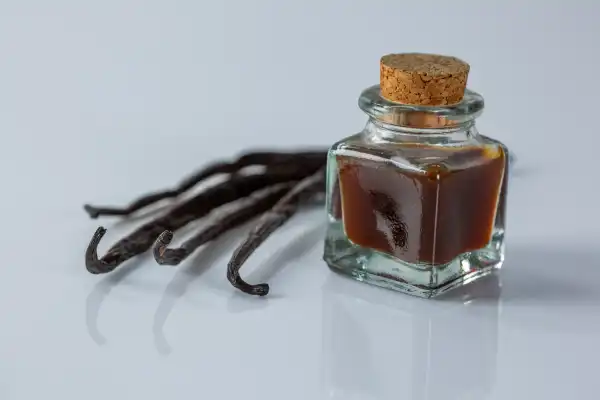Access our First Foods® Database in the Solid Starts App.
Learn moreVanilla
Herb/Spice
Age Suggestion
6 months
Iron-Rich
No
Common Allergen
No

When can babies have vanilla?
Vanilla may be introduced as soon as baby is ready to start solids, which is generally around 6 months of age.
Vanilla comes from the fermented and dried bean pods of an orchid that originated in the tropical forests of North and Central America. While chocolate and vanilla is a common pairing today, Aztec people were brewing drinks made with cacao and vanilla thousands of years ago. Colonization of the Americas introduced vanilla around the globe, but it wasn’t until an enslaved person named Edmond discovered how to hand-pollinate the plant in the absence of its native pollinators that the global vanilla trade took off.
How do you serve vanilla to babies?
Every baby develops on their own timeline, and the suggestions on how to cut or prepare particular foods are generalizations for a broad audience.
6 months old +:
Use a small amount of vanilla extract to season french toast, pancakes, waffles, and baked goods like bread or muffins. Alternatively, whip a small amount into cream or full-fat coconut milk, or scrape the seeds of a vanilla pod into the batter when making your favorite baked good. You can also sprinkle a tiny amount of vanilla powder into soft, scoopable foods like warm cereals, rice puddings, or yogurt. Sharing an occasional bite of dessert is not a cause for concern as part of a varied diet. It can be helpful to hold off on regularly offering desserts until the child is older to help support baby’s oral health and ensure that baby has space in the belly to try a variety of nourishing foods.
24 months old +:
Cook with vanilla beans, vanilla extract, and other vanilla products as desired in baked goods and other dishes. At this age, you can also serve sweetened products made with vanilla as part of a variety of foods, from cakes to flan to ice cream.
Not sure what food to try next? Have a look at our guide, 50 Fantastic First Foods for Babies.
Videos
Is vanilla a choking hazard for babies?
It can be. Whole vanilla pods or pieces of vanilla pods, when left in a dish, are small and firm, qualities that increase the risk of choking. Vanilla extracts and powders pose a low risk of choking, although the food they season can be a choking hazard. To reduce the risk, prepare and serve foods that contain vanilla in an age-appropriate way. As always, make sure you create a safe eating environment and stay within an arm’s reach of baby during meals. For more information on choking, visit our sections on gagging and choking and familiarize yourself with the list of common choking hazards.
Is vanilla a common allergen?
No. Allergies to vanilla are not common, although cases of rashes being caused by contact and ingestion of vanilla have been reported.
A small study of young children with severe eczema suggested that vanilla and vanillin-containing compounds, such as Balsam of Peru, might be contributing to difficult-to-control eczema in the form of food flavorings.
Even in the absence of allergy, foods with spices like vanilla may cause a harmless rash around the mouth while baby eats or may cause or worsen diaper rash. To help prevent contact rashes, apply a thin layer of barrier ointment (such as pure petroleum jelly or a plant-based oil or wax balm) to baby’s face and bottom before mealtime.
As you would when introducing any new food, start by offering a small quantity for the first few servings. If there is no adverse reaction, gradually increase the quantity over future meals.
Is vanilla extract safe for babies?
Yes. Vanilla extract is generally recognized as safe in amounts typically used in cooking. While vanilla extract does contain alcohol, the tiny amounts typically used in baked goods and meals mean that it is fine to add vanilla extract to foods for baby. You can further reduce the risk of any alcohol exposure by thoroughly cooking the food that has vanilla extract in it (to reduce the alcohol content) or purchase an alcohol-free vanilla extract.
That said, out of an abundance of caution, keep bottles of vanilla extract out of the reach of children. When accidentally ingested in large amounts, vanilla extract can cause alcohol poisoning.
Is vanilla healthy for babies?
Yes. Vanilla bean offers around 200 different plant compounds, including vanillin which may offer anti-inflammatory, antimicrobial, and antioxidant properties. When used in typical amounts in recipes, vanilla extract is safe to use for babies and young children.
Vanilla is commonly featured in many desserts and sweetened forms, including vanilla frostings, sugars, and syrups. Sharing an occasional bite of these with baby as part of a varied diet is not a cause for concern. It can be helpful to hold off on regularly offering desserts until a child is older to help support baby’s oral health and ensure that baby has space in the belly to try a variety of nourishing foods. When it comes to navigating sweet foods like desserts, aim for balance: do your best, and try to avoid tracking and controlling a child’s food intake to help support cultivating a positive relationship with all foods for the child.
Is imitation vanilla safe for babies?
Yes, in amounts typically used in cooking. Imitation vanilla is typically made from alcohol infused with synthetic vanillin, a lab-made version of the distinctive compound that gives vanilla beans their flavor and aroma. Vanilla extract tends to be more expensive, while imitation vanilla is much more accessible and tends to have a less complex flavor. Choose whichever product works for you and your family.
Our Team
Written by
Expert Tips Delivered to Your Inbox
Sign up for weekly tips, recipes and more!
Copyright © 2025 • Solid Starts Inc






